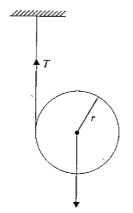A solid cylinder of mass 50kg and radius 0.5m is free to rotate about the horizontal axis. A massless string is wound round the cylinder with one end attached to it and other end hanging freely. Tension in the string required to produce an angular acceleration of 2 revolution s−2 is
25N
50N
78.5N
157N
The correct Answer is:d
To solve the problem, we need to find the tension in the string that produces an angular acceleration of the solid cylinder. Here’s a step-by-step solution:
Step 1: Convert Angular Acceleration
The angular acceleration is given as 2revolutions/s2. We need to convert this to radians per second squared because the standard unit for angular acceleration in physics is radians.
α=2revolutions/s2×2πradians/revolution=4πradians/s2
Step 2: Calculate Moment of Inertia
The moment of inertia I for a solid cylinder rotating about its central axis is given by the formula:
I=12mr2
Where:
- m=50kg (mass of the cylinder)
- r=0.5m (radius of the cylinder)
Substituting the values:
I=12×50kg×(0.5m)2=12×50×0.25=6.25kg m2
Step 3: Relate Torque and Angular Acceleration
The torque τ produced by the tension T in the string is given by:
τ=T×r
According to Newton's second law for rotation, the relationship between torque and angular acceleration is:
τ=Iα
Step 4: Set Up the Equation
Equating the two expressions for torque:
T×r=Iα
Substituting the known values:
T×0.5=6.25×4π
Step 5: Solve for Tension
Now we can solve for T:
T=6.25×4π0.5
Calculating the right side:
T=25π0.5=50π
Using π≈3.14:
T≈50×3.14=157N
Final Answer
The tension in the string required to produce the specified angular acceleration is approximately:
157N
---
The angular acceleration is given as 2revolutions/s2. We need to convert this to radians per second squared because the standard unit for angular acceleration in physics is radians.
The moment of inertia I for a solid cylinder rotating about its central axis is given by the formula:
- m=50kg (mass of the cylinder)
- r=0.5m (radius of the cylinder)
The torque τ produced by the tension T in the string is given by:
Equating the two expressions for torque:
Now we can solve for T:
The tension in the string required to produce the specified angular acceleration is approximately:
Similar Questions
A solid cylinder of mass 2 kg and radius 4 cm rotating about its axis at the rate of 3 rpm. The torque required to stop after 2π revolutions is :
View SolutionA soild cylinder of mass 2 kg and radius 0.2 m is rotating about its owm axis without friction with an angular velocity of 3 rad s−1 . Angular momentum of the cylinder is
View Solution
Knowledge Check
A solid cylinder of mass M and radius R rotates about its axis with angular speed ω. Its rotational kinetic energy is
A12MR2ω2BMR2ω2C14MR2ω2D18MR2ω2
Figure shows a solid uniform cylinder of radius R and mass M, which is free to rotate about a fixed horizontal axis O and passes through centre of the cylinder. One end of an ideal spring of force constant k is fixed and the other end is higed to the cylinder at A. Distance OA is equal to R2. An inextensible thread is wrapped round the cylinder and passes over a smooth, small pulley. A block of equal mass M and having cross sectional area A is suspended from free end of the thread. The block is partially immersed in a non-viscous liquid of density ρ.
If in equilibrium, spring is horizontal and line OA is vertical, calculate frequency of small oscillations of the system.

View SolutionA bucket of mass 8 kg is supported by a light rope wound around a solid wooden cylinder of mass 12 kg and radius 20 cm free to rotate about its axis. A man holding the free end of the rope, with the bucket and the cylinder at rest initially, lets go the bucket freely downwards in a well 50 m deep. Neglecting friction, obtain the speed of the bucket and the angular speed of the cylihder just before the bucket enters water.
View SolutionA uniform disc of radius R and mass M is free to rotate only about its axis. A string is wrapped over its rim and a body of mass m is tied to the free end of the string as shown in the figure. The body is released from rest. Then the acceleration of the body is

View SolutionA uniform disc of radius R and mass M is free to rotate only about its axis. A string is wrapped over its rim and a body of mass m is tied to the free end of the string as shown in the figure. The body is released from rest. Then the acceleration of the body is

View SolutionOn the surface of a solid cylinder of mass 2 kg and radius 25 cm a string is wound several times and the end of the string is held stationary while the cylinder is released from rest. What is the acceleration of the cylinder and the tension in the string ?

View SolutionA uniform disc of mass M and radius R is mounted on a fixed horizontal axis. A block of mass m hangs from a massless string that is wrapped around the rim of the disc. The magnitude of the acceleration of the falling block (m) is
View SolutionA man pulls a solid cylinder ( initially at rest ) horizontal by a massless string. The string is wrapped on the cylinder and the cylinder performs pure rolling. Mass of the cylinder is 100kg, radius is π metre & tension in string is 100N. Then the angular speed of the cylinder after one revolution will be :

View Solution